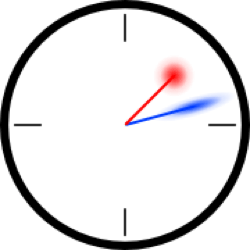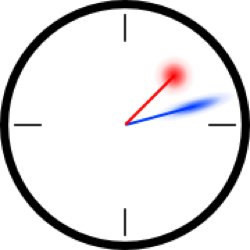Atomic Clock Beats the Quantum Limit
The best atomic clocks are limited by the uncertainty principle–quantum-scale fluctuations prevent measurements from being perfectly precise. But reports in the 19 February and 25 June Physical Review Letters show that the fluctuations can be moved into other measurable quantities that don’t affect the time measurement. Although the new clock isn’t as good as the best ones now available, it shows that the quantum limit can be evaded for future precision experiments and satellite-aided navigation.
Atomic clocks are based on atoms that have a choice of two states, a ground state and an excited state. The difference in energy between the states determines the frequency of an intrinsic oscillation that is set up when the atom starts out in a combination state. Experimentalists can’t measure this oscillation directly, but it’s often represented by a point that continually rotates around the circumference of a circle or the surface of a sphere. The angle through which this point has moved since the beginning of an experiment is called the phase. A precise measurement of the phase is the goal of a clock because the rotation speed is a known quantity, fixed by the difference in energy of the two atomic states.
But quantum fluctuations embodied in the uncertainty principle limit the precision with which this phase can be measured, and for a decade the best atomic clocks have approached this limit. In principle, though, researchers have known how to do better. The inherent uncertainty applies to the product of two variables, such as the momentum and position of a particle, so the uncertainty in one variable can be reduced at the cost of increasing the uncertainty in the other, a trick called squeezing.
For the atomic clock, instead of position and momentum, the two “complementary” variables are phase and a quantity describing which of the two states the atom is in. To maximize the uncertainty in this quantity–and therefore minimize the phase uncertainty–it turns out that researchers must combine many atoms into a single “entangled” state, in which their individual properties are all linked. The state of this much larger quantum object is represented as a point on a correspondingly larger sphere, where phase is longitude and the complementary variable (state population) is latitude. The uncertainty is an ellipse around the point, and the goal is to make the ellipse extended in latitude and “squeezed” in longitude.
Labs worldwide are trying several different squeezing schemes, but a team led by Vladan Vulević of the Massachusetts Institute of Technology in Cambridge and another led by Eugene Polzik of the University of Copenhagen [1] are the first to make a clock. In their February PRL paper, the MIT team described using laser-light pulses to entangle atoms in an optical cavity. The conditions allowed the two complimentary variables–phase and atomic state populations–to affect one another without either being measured directly. This situation led to entanglement and to narrowing of the uncertainty ellipse.
In their latest work, the team translated their reduced phase uncertainty into a clock. To do this, they applied microwave pulses to put the state of the atoms on the equator–halfway between the ground and excited states (south and north poles)–and then allowed the state to move around the equator for a period of time. Then more pulses allowed the team to measure the progress of the state, that is, measure the phase and calculate the time. The procedure is mathematically identical to the way researchers rotate nuclear spins in spin-resonance experiments. The final timing fluctuations were about three times smaller than they measured without the squeezing.
Still, the clock is “not, by absolute standards, a very good one,” admits MIT team member Ian Leroux, because other noise sources prevent the long observation times used in the most accurate clocks. But clock expert Christophe Salomon of the École Normale Supérieure in Paris says the new results are “a pleasure to read,” and he suspects that “there is no fundamental issue why [remaining] classical noise cannot be totally cancelled.”
–Don Monroe
Don Monroe is a freelance science writer in Murray Hill, New Jersey.
References
- A. Louchet-Chauvet, J. Appel, J. J. Renema, D. Oblak, N. Kjærgaard, and E. S. Polzik, “Entanglement-Assisted Atomic Clock beyond the Projection Noise Limit,” New J. Phys. 12 065032 (2010)
More Information
Fountain Clock Keeps Good Time (Focus, 1999)





